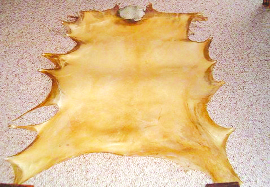
High prices put a damper on rawhide sales
Ismail Hossain | Saturday, 17 October 2015

Country's tanners have yet to start buying rawhides on a large scale even three weeks after the Eid-ul-Azha festival rather they are adopting a 'wait and see policy' because of its increased prices in the market.
Even though traders purchased rawhides and skins on a full scale out of fear for its smuggling into neighbouring India, now they could not sell as tanners were averse to buying them.
Tanners said they would not purchase rawhides of sacrificial animals at higher prices.
"Many tanners have enough stockpiles of rawhides since last year. So, they don't need to purchase rawhides at higher prices," said M Abu Taher, chairman of Bangladesh Finished Leather, Leather Goods and Footwear Exporters Association (BFLLGFEA).
"I myself didn't purchase a piece of rawhide due to higher prices," he added.
After visit to Posta of Lalbagh in the city, this correspondent found that the prices of cowhide, which declined significantly during Eid-ul-Azha this year compared to that of previous years, increased sharply.
Ali Hossain, former president of Bangladesh Hide and Skin Merchants Association (BHSMA), an organisation of traders who collect rawhides and sell them to tanners, said around 40 per cent of rawhide and skin had been sold during this Eid.
"Tanners are showing reluctance to purchase rawhides." Traders cannot cut the prices as they had to buy rawhides at higher prices, he added.
Even after fixing prices, rawhides of sacrificial animals were traded on Friday at higher prices at Posta, the largest rawhide market in the city.
Tanners, who need to purchase rawhides urgently, are collecting them at up to Tk 90 per square foot against fixed rate of Tk 50-55.
A day before Eid, tanners fixed the price of cowhide at Tk 50-55 per square foot (sft) in Dhaka and Tk 40-45 per sft outside the capital during the Eid season.
Bangladesh Tanners Association (BTA), BHSMA and BFLLFEA at a press conference in the city announced the prices for purchasing different types of rawhides.
Mr Taher said tanners had purchased maximum 40 per cent of rawhides until Friday. Usually tanners purchase at least 60 per cent of rawhides of sacrificial animals in three weeks after the religious festival, he added.
According to hide merchant associations in eight divisional cities, different types of cowhides were traded at Tk 70-Tk 90 per sq ft across the country on Thursday and Friday which was Tk 50-60 per sq ft earlier.
BTA President Shahin Ahmed said, "We cannot purchase raw materials at high rates as its prices are showing downward trend in the international market."
There are 250 warehouses at Posta which can accommodate 300,000 pieces of rawhides. The warehouses at Aminbazar in Savar have room for another 100,000 pieces.
Tanners alleged that in last few years, some seasonal traders, blessed by political leaders, got involved in business during Eid-ul-Azha and controlled the market.
After building up a network, big players having own capacity of stocking hides purchase rawhides of sacrificial animals, they said.
More than 6.5 million cattle were sacrificed during the Eid-ul-Azha last year, according to data available with Department of Livestock.
Nearly 70 per cent of the country's annual demand for hide and skin are met from animals slaughtered during the Eid-ul-Azha while 10 per cent during Eid-ul-Fitr and two per cent during Shab-e-Barat.
[email protected]